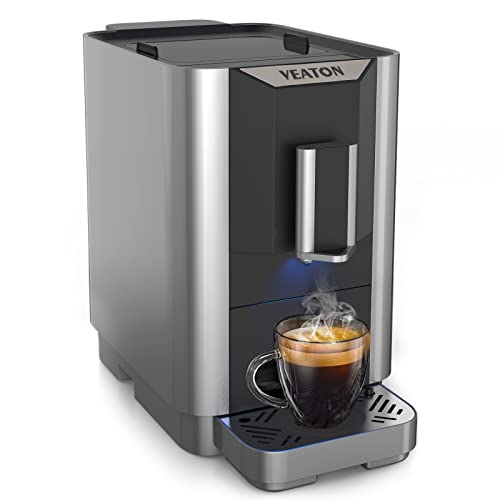How to Maintain Espresso Machines
Businesses such as car dealerships hair salons and doctor's offices can benefit from offering espresso drinks. These drinks of gourmet quality can improve your customers' patience while they wait for service and can improve the overall atmosphere in your establishment.
A Good Housekeeping 2022 Espresso Machine winner, this cutting-edge machine uses a smart dosing system to weigh and distribute the right amount of ground coffee for each shot. It also includes a milk frother which performed well in our tests.
bean to cup espresso machine are a great addition to any home or office. They can be used for numerous drinks, including lattes and cappuccinos. They function by pushing hot coffee into the ground under pressure that is high. This results in a concentrated shot of coffee that is extremely delicious. It has a significant amount of caffeine, which can be an effective stimulant.
These types of machines are available in a range of sizes from compact models that are ideal for residential use to larger models specifically designed for commercial use. They are available in both semi-automatic as well as manual designs. Manual machines require the operator to manage the flow of water and pressure, and semi-automatic models include an inbuilt pump that will do this for you. Some semi-automatic machines have a grinder, while others don't. The kind of machine you select will depend on your budget and personal preferences.
The manual espresso machine operates by turning a handle which pushes water through the grounds of an evaporator. This type of machine is typically referred to caffettiera or macchinetta and is the most common form of espresso maker. It features an inner chamber that holds the water and an upper chamber with an aluminum filter. When heated, steam is pushed through the coffee grounds before being pushed into the top of the machine, from where the espresso is ready for serving.
Variety
There are various kinds of espresso machines based on your requirements. There are semi-automatic, manual, and fully automatic espresso machines. Each machine has its own distinctive way of producing espresso shots and other beverages such as lattes and cappuccinos.
The first machines were not fully automated. They required the user to manually operate the lever to create the required pressure to trigger the shot. These machines are still available but they aren't as common due to the effort required and the stress they could cause. Modern espresso machines produce pressure using a variety such as screw, push and see-saw designs. This allows the user to regulate the amount of pre-infusion more precisely than a lever machine.
Pump-driven espresso machines are similar to stovetop mokapots however, they use an electric motor to press the coffee grounds instead of steam. They are equipped with a boiler, which is heated to a point of boiling then a pump pushes it through a group head to the coffee. They are the most popular types of espresso machines and are generally less expensive than other varieties.
Semi-automatic espresso machines bring together the best features of both pump-driven and manual espresso machines. They allow you to grind the beans and tamp them, however the motor is responsible for controlling the pressure to ensure consistency. They also have a separate chamber that is heated and froths milk and some are equipped with a built-in grinder.
Functions
Commercial espresso machines make many different coffees and espressos at the touch of an button. They use pre-packaged espresso capsules that are precisely dosed and packaged to make a single cup of espresso or coffee. These machines are extremely popular in offices with lots of traffic because they do away with the requirement for a grinding machine, dosing, and tamping. However, since they do not have steam functions, you'll need a separate milk frother to make lattes and cappuccinos.
Many cafes across Europe employed steam machines to increase production and decrease brewing time. These early machines were heated on an open flame, which resulted in inconsistent temperature and pressure. The inventor Angelo Moriondo of Turin, Italy is credited with creating the first machine that was capable of making espresso without using steam.
The most commonly used type is the pump-driven espresso machine. These machines utilize portsafilters to hold the ground espresso beans. When the valve switches to the espresso position, the espresso is extracted from the water under 15 atmospheres of pressure in a heating vessel. After the brew is completed, the portafilter is removed and emptied to be cleaned.
Automated espresso machines bring automation to semi-automatic systems by controlling the extraction time by utilizing internal or volumetric timers. They also eliminate the barista’s ability to grind or tamp coffee, which can affect the quality of the final product.

Maintenance
Espresso machines may not be the most attractive equipment in a café, but they are extremely important. The way you maintain your espresso machine will affect the quality and taste of your drinks.
Clean espresso machines ensure that the taste of your coffee will not be compromised, and your customers will enjoy a pleasant experience. Maintaining a regular schedule of cleanings and maintenance will also extend the lifespan of your espresso machine to ensure it lasts for years.
Clean the portafilter and the baskets at minimum once per shift with a damp cloth to get rid of the oils and residue left behind. Backflush the gasket between the portafilter head as well as the grouphead by inserting the nylon brush and moving it to remove any buildup. Rinse the gasket with water and then run it through until the water is clear.
Mix espresso machine cleaner with water in a container according to the instructions of the manufacturer once a week, or as required. Then soak portafilters and baskets in the cleaning solution for a night. If your espresso maker comes with a steam wand or screen, remove them from the group using an screwdriver. In separate soaking, soak them in the cleaning liquid.
